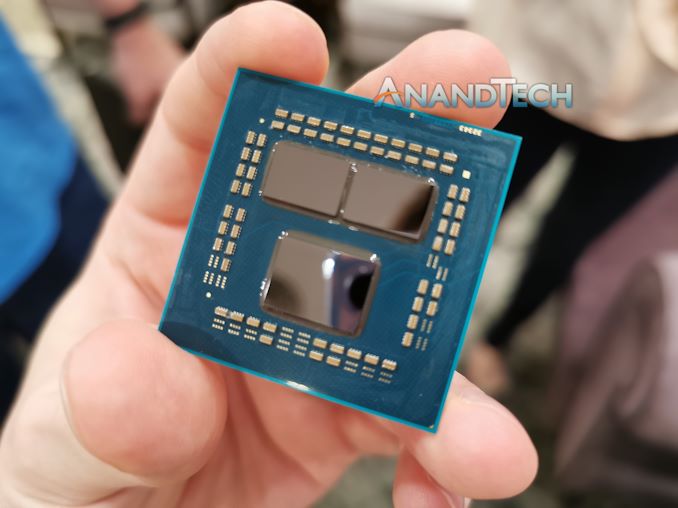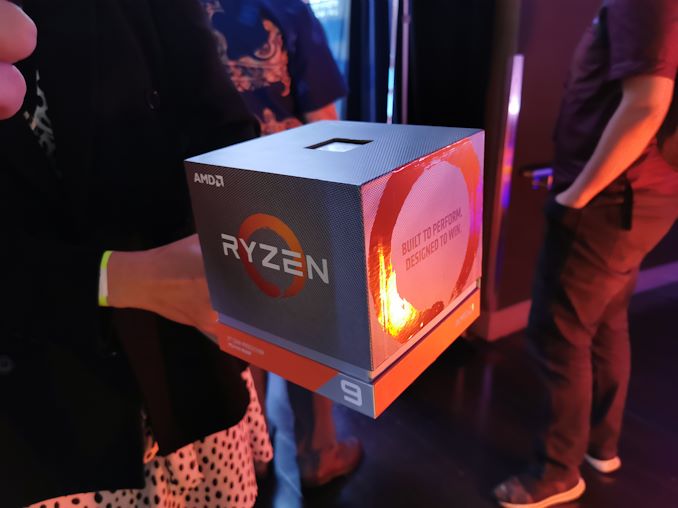AMD 16-Core Ryzen 9 3950X: Up to 4.7 GHz, 105W, Coming September
by Dr. Ian Cutress on June 11, 2019 6:00 PM EST- Posted in
- CPUs
- AMD
- Ryzen
- Zen 2
- Ryzen 3000
- Ryzen 3rd Gen
- Ryzen 9
- 3950X

One of the questions that was left over from AMD’s Computex reveal of the new Ryzen 3000 family was why a 16-core version of the dual-chiplet Matisse design was not announced. Today, AMD is announcing its first 16 core CPU into the Ryzen 9 family. AMD stated that they’re not interested in the back and forth with its competition about slowly moving the leading edge in consumer computing – they want to launch the best they have to offer as soon as possible, and the 16-core is part of that strategy.
The new Ryzen 9 3950X will top the stack of new Zen 2 based AMD consumer processors, and is built for the AM4 socket along with the range of X570 motherboards. It will have 16 cores with simultaneous multi-threading, enabling 32 threads, with a base frequency of 3.5 GHz and a turbo frequency of 4.7 GHz. All of this will be provided in a 105W TDP.
| AMD 'Matisse' Ryzen 3000 Series CPUs | |||||||||||
| AnandTech | Cores Threads |
Base Freq |
Boost Freq |
L2 Cache |
L3 Cache |
PCIe 4.0 |
DDR4 | TDP | Price (SEP) |
||
| Ryzen 9 | 3950X | 16C | 32T | 3.5 | 4.7 | 8 MB | 64 MB | 16+4+4 | ? | 105W | $749 |
| Ryzen 9 | 3900X | 12C | 24T | 3.8 | 4.6 | 6 MB | 64 MB | 16+4+4 | ? | 105W | $499 |
| Ryzen 7 | 3800X | 8C | 16T | 3.9 | 4.5 | 4 MB | 32 MB | 16+4+4 | ? | 105W | $399 |
| Ryzen 7 | 3700X | 8C | 16T | 3.6 | 4.4 | 4 MB | 32 MB | 16+4+4 | ? | 65W | $329 |
| Ryzen 5 | 3600X | 6C | 12T | 3.8 | 4.4 | 3 MB | 32 MB | 16+4+4 | ? | 95W | $249 |
| Ryzen 5 | 3600 | 6C | 12T | 3.6 | 4.2 | 3 MB | 32 MB | 16+4+4 | ? | 65W | $199 |
AMD has said that the processor will be coming in September 2019, about two months after the initial Ryzen 3rd Gen processors, due to extra validation requirements. The chip uses two of the Zen 2 eight-core chiplets, paired with an IO die that provides 24 total PCIe 4.0 lanes. By using the AM4 socket, AMD recommends pairing the Ryzen 9 3950X with one of the new X570 motherboards launched at Computex.
With regards to performance, AMD is promoting it as a clear single-thread and multi-thread improvement over other 16-core products in the market, particularly those from Intel (namely the 7960X).
There are several questions surrounding this new product, such as reasons for the delay between the initial Ryzen 3000 launch to the 3950X launch, the power distribution of the chiplets based on the frequency and how the clocks will respond to the 105W TDP, how the core-to-core communications will work going across chiplets, and how gaming performance might be affected by the latency differences going to the IO die and then moving off to main memory. All these questions are expected to be answered in due course.
Pricing is set to be announced by AMD at its event at E3 today. We’ll be updating this news post when we know the intended pricing.
Update: $749
Related Reading
- AMD Ryzen 3000 Announced: Five CPUs, 12 Cores for $499, Up to 4.6 GHz, PCIe 4.0, Coming 7/7
- AMD Ryzen 3rd Gen 'Matisse' Coming Mid 2019: Eight Core Zen 2 with PCIe 4.0 on Desktop
- AMD: 3rd Gen Ryzen Threadripper in 2019
- AMD Confirms PCIe 4.0 Not Coming to Older Motherboards (X470, X370, B350, A320)
- ASUS Pro WS X570-Ace: A No-Nonsense All-Black Motherboard with x8/x8/x8
- GIGABYTE Unveils X570 Mini-ITX Motherboard: X570 I Aorus Pro WiFi
- ASRock X570 Aqua: Heaviest AMD Flagship Motherboard Ever (Plus Thunderbolt)
- MSI Unveils the MEG X570 Ace: Black and Gold For AMD 50












172 Comments
View All Comments
LegionR - Wednesday, June 12, 2019 - link
The 16-core one is definitely not targeted towards gamers, it's for people who actually perform worthwhile tasks like design, rendering and many more.xrror - Monday, June 10, 2019 - link
Okay AnandTech, I give you a mission. (pre-post edit: assuming you can get parts/samples of course)Whenever the 3950X becomes available... test it on something with good bios support but is "cheap and cheery" in the channel.
By that I mean something stupid like say (ASRock AB350M PRO4) or sure random Asus Strix x50 board.
Because seriously, that sort of combo truly highlights what AMD is offering with AM4 compatibility.
I... hope? There are enough readers, who on a budget, reading Anandtech for info, are interested in the possibility of what a 3600 or 3700 on their "old" 3xx and 4xx series AM4 boards would do for them.
Using a 3950X on a B350 board sure is... the extreme case but also - if that combo shines means AMD executed perfectly. BUT any faults in that combo would also be super informative in things to look out for.
I wish I could wordcraft better - the fact that the above combo is possible... is awesome!
We're in a fun time (again!) where AMD is on the cusp of being underdog to leadership (for a bit) and we get things like socket AM4 for more than 2 gens of proc.
This is a bit of an opportunity, since we don't get things like core 2 quad on old Pentium 4 chipsets (975x P5W DH Deluxe) because Intel loves us (the last era Intel really got pushed). A weaker analog on the AMD side is Thurban Phenom x6 to FX transition AM2 AM2+ AM3.
I guess my rambling incoherent hardware love letter is this. Test a 3950x on the nearest to $85 AM4 motherboard that isn't a known pile of garbage, and ... you know even if it throttles a bit, if that is a working combo, slamming a $750 proc on your existing $85 board and it doesn't explode and actually, even if throttled is still 364.6% faster as a drop in upgrade to your self built computer from 2 years ago...
That's a huge win for AMD. And why I love PC hardware ;)
jeremyshaw - Monday, June 10, 2019 - link
That's exactly my usecase right now.B350 ITX board (ASRock), currently serving HTPC duties. If it has a better future replacing my Z270 Intel setup, I'll upgrade early. If it doesn't, I'll probably wait.
Hul8 - Monday, June 10, 2019 - link
AMD is recommending combining the 3950X only with a X570 motherboard - presumably because of the power delivery quality/headroom.I wouldn't put it past them to limit which chipsets are qualified for (overclocking) the 12- and 16-core parts due to power constraints.
It makes perfect sense, since that way
1) motherboard vendors don't need to overbuild the power delivery on the lower end boards, saving costs and allowing lower prices (and the budget options that are sorely missing in all vendors' X570 lineups);
2) the chipsets get differentiated more, since overclocking a high-end CPU will *require* that expensive X570 board.
PCIe 4 support would be another way to differentiate and cut costs: Support for it may be cut entirely on B550 (for both CPU and chipset). Would anyone want to use the $750 16-core CPU on a motherboard with only PCIe 3? Not being able to add a PCIe 4 SSD a year from now, when they're probably more readily available from most manufacturers?
xrror - Tuesday, June 11, 2019 - link
I don't disagree on AMD's recommended. I just want to know on AMD's "technically valid but not-recommended" where if the mobo maker didn't totally cheap out - you have a surprise winner.To be realistic, if any mobo vendor did something nuts like... enable 3950x support on an A320 board. When that combo exploded overclocked? I'm torn in that it is awesome that you could use that proc on a board that was made before those demands could be imagined, but it sucks that you're going to blame the maker of your $40 mobo that they gave you the ability to explode your system with a $750 proc.
But I would like to see some runs with the 3600 and 3700 with some budget B350 boards.
I show my age when I get angry that motherboard makers that have the... cahoons to release beta bios's that let boards operate "outside of specification" over the years have gotten slammed for releasing "bad" bios's and/or motherboards because Joe/Jane bob can't comprehend "when this bios voltage number is flashing red/white with a skull, that might not be a good thing long term"
Hul8 - Tuesday, June 11, 2019 - link
The TDPs present of the Ryzen 3rd gen are the same as Ryzen 2nd gen. (Gen 1 didn't have 105W, IIRC.) The TDP only applies to stock operation, though.The problem arises from having 50% or 100% more cores than you used to; At that point the power demands from more voltage and frequency stack up quickly and the earlier generation motherboards may not allow much power headroom.
Up to 8 cores should be fine, and overclocking on B350/450 similar to Ryzen 2000 with the same core count.
SaturnusDK - Tuesday, June 11, 2019 - link
It's not only that. Smaller lithographies means lower voltage so that means in order to deliver the same power, you have to supply more ampere. That's not an easy task, and why some B350/X370 MBs in particular might have problems with even the 12 core 3900X. It's much easier to provide low amp at high voltage than the reverse. But we shall see in testing.TheUnhandledException - Tuesday, June 11, 2019 - link
The 3700X has lower TDP. The 3700X is 65W. The 2700X was 105W and the 1700X was 95W. The 3700X is looking like one nice CPU. No clock improvement over the 2700X but 15% higher IPC and 1/3rd less power? Yes Please.jeremyshaw - Tuesday, June 11, 2019 - link
Eh, we already see with the 2700X that AMD doesn't always strictly adhere to the classical TDP definition. Anandtech's Ryzen 2 review covers that. System power consumption for CPU-only tasks on the 2700X seem to match Intel's 9900k, and the 2600X system power for CPU-only tasks seem to exceed the 8700k.I know Anandtech writers are in love with trusting power readings from internal CPU registers, but in the end, total system power draw doesn't lie. We also know some tools (like HWInfo) are not reliable at measuring AMD Ryzen power draw (the creator of HWInfo believes AMD engineers don't know their own CPU, and HWInfo underreports AMD power draw significantly - by almost 2:1 on my E485 laptop [Ryzen 2500U], vs AMD's own performance profiling tool).
Hul8 - Tuesday, June 11, 2019 - link
Tom's Hardware publishes power figures from their German sister site who directly measure consumption from individual power cables and a PCIe riser.Gaming loop:
- Ryzen 7 2700X: 55.7W
- Core i7-8700K: 66.8W
Torture loop:
- 2700X: 104.7W
- 8700K 159.5W
Source:
Test setup on page 4: https://www.tomshardware.com/reviews/amd-ryzen-7-2... (power measuring hardware near the bottom of the page)
Power results on page 12: https://www.tomshardware.com/reviews/amd-ryzen-7-2...